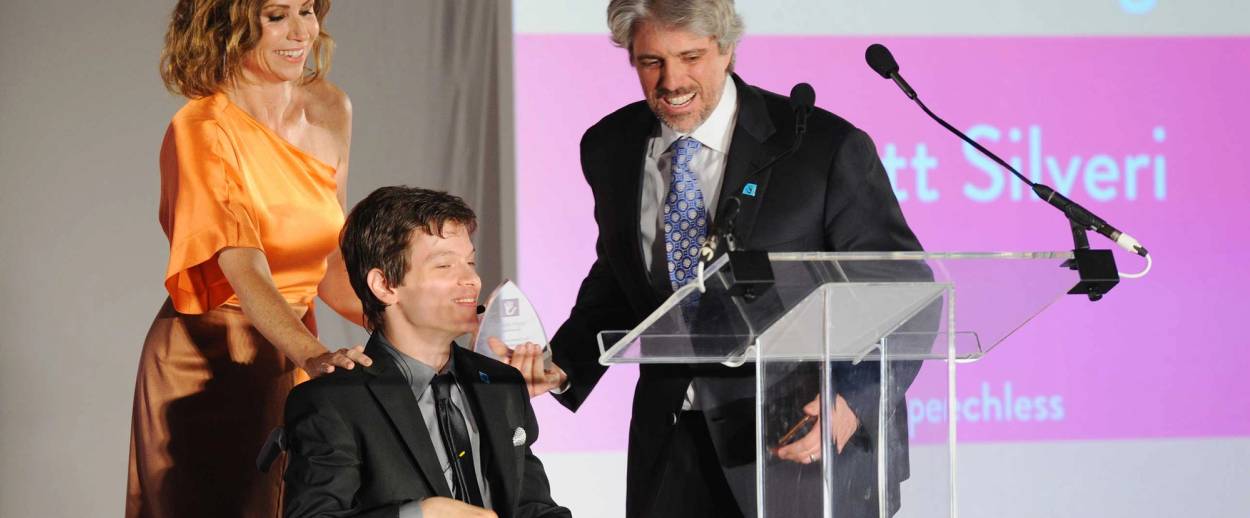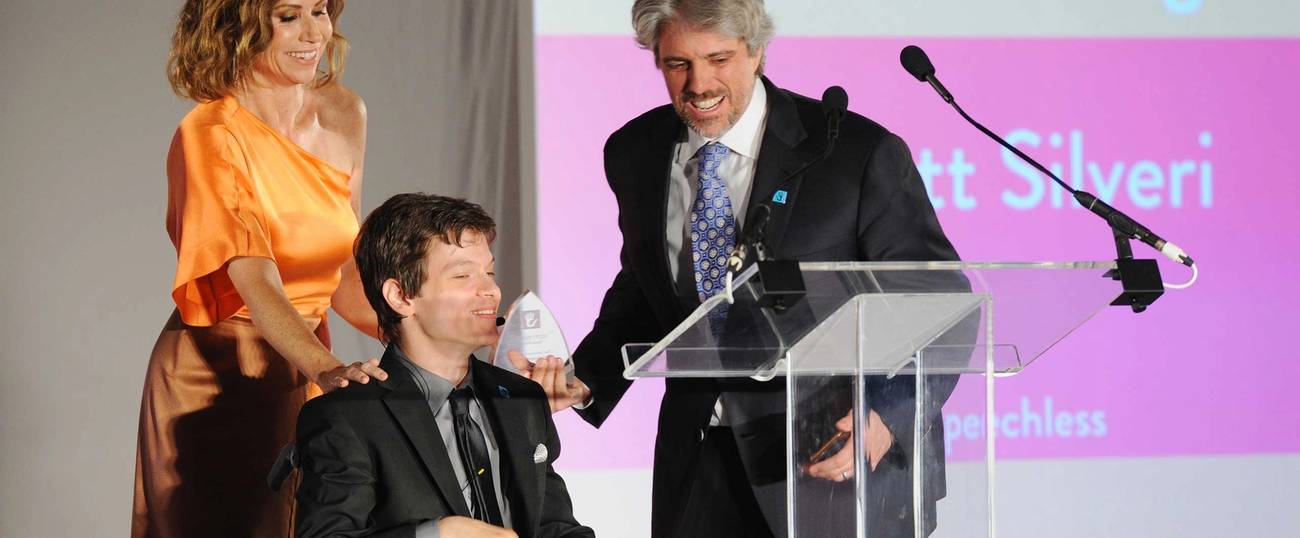When the movie Wonder opened last month, some criticized the choice to have a nondisabled actor play the role of Auggie, a boy with severe facial disfigurement. For these critics, the decision was yet another example of the way people with disabilities are excluded.
Advocates for the disabled have long been fighting for greater inclusion of people with physical and cognitive disabilities in all spheres of life, particularly in education, recreation, and employment. Among the most vocal of these advocates are leaders of Jewish organizations who say Jewish values are at the core of their work. “Everything comes back to treating someone well. If you’re not doing that, you’re not living up to Jewish values,” said Lauren Appelbaum, communications director of RespectAbility, based in Rockville, Maryland. Though it is not a Jewish organization, several of its core staff have strong ties to the organized Jewish community. As such, the agency has made Jewish inclusion a priority, choosing students to serve as Jewish Inclusion Fellows and maintaining a Jewish Inclusion Facebook page.
Jay Ruderman, president of the Ruderman Family Foundation, sees the intersection of Jewish identity and disability inclusion through a historical lens. “This is a civil-rights issue,” he said. “Jews have been at forefront of civil-rights movements. We have the historical perspective of being outcasts, so we can empathize with other groups who have their rights discriminated against.”
For Isaac Zablocki, director of film programs at JCC Manhattan, specific Jewish tenets, including making others feels more welcome, making the community more accessible, and valuing all human life, line up perfectly with the ideals of inclusion: “There’s a reason why Jewish organizations are leading this movement,” he said.
Many Jewish groups have chosen the performing arts as a target for greater inclusion. For some, this means giving people with disabilities more opportunities to engage in and be exposed to music, theater, dance, and film, often alongside nondisabled peers. Because the arts can be enjoyed by everyone, they offer a way for everyone to feel included, said Abbie Weisberg, executive director/CEO of Keshet, an organization in Chicago serving people with disabilities. “Having special needs can be a very isolating experience,” she said. “With involvement in the arts, there’s a strong sense of belonging.”
The JCC Manhattan’s Adaptations program gives adults with special needs the chance to immerse themselves in the performing arts, offering everything from an inclusive a cappella chorus to a literary club to a talent showcase to gallery and Broadway show outings, explained program director Caitlin McInerney. The program also invites the Epic Players, a self-described “neuro-inclusive theater company,” to hold auditions at the JCC for Adaptations members. Those who join the Epic Players have access to all the company’s workshops and the opportunity to participate in as many as three productions a year.
Keshet offers an integrated choir, comprising children with a range of disabilities and members of the Chicago Children’s Choir, which performs at the agency’s annual fundraiser to great fanfare, said Weisberg. “No one ever wants to go to a fundraiser,” she said. “Our fundraiser gets 1,200 to 1,500 people who say, year after year, that the highlight is the choir.”
Hillel International, which oversees Jewish campus life, strives to engage students with disabilities, said Sheila Katz, vice president of student engagement and leadership. Inclusion initiatives often focus on the arts, such as Dance 4 Empowerment, a nonprofit whose mission is to fund inclusive dance programs.
Inclusion advocates see the performing arts as an ideal outlet for people with disabilities. Weisberg has seen children and adults with major challenges make great strides through theater. She gives the example of a young man she knew who used to injure himself as a result of anxiety. He is now living semi-independently, thanks in part to his involvement in theater, she said, which gave him a way to express himself and feel less anxious.
For other Jewish organizations, disability inclusion in the performing arts means advocating for greater representation and inclusion of people with disabilities on the screen and stage. One of the leaders of this movement is the Ruderman Family Foundation. In 2016, the foundation published the results of a study that found people with disabilities make up less than 1 percent of TV characters, despite making up 20 percent of the population, according to U.S. Census Bureau data. Of this tiny number of disabled roles, 95 percent were played by nondisabled actors. In September of this year, the foundation issued a challenge to creators of TV pilots to audition and cast more actors with disabilities for the 2017-18 season.
“We think entertainment is hugely influential on people’s attitudes,” Ruderman said. “People spend more time watching entertainment than talking to family or neighbors.”
Other Jewish groups have also taken up the cause of greater representation of people with disabilities in the arts. In 2007, JCC Manhattan founded the ReelAbilities Film Festival, which screens films by and about people with disabilities. The festival started in New York and has spread to cities across the country.
“We seek out high-quality films that portray disability in an authentic way,” said Zablocki, who co-founded the festival. “A lot of films [about disability] … go for the pity effect. We look for films that push the envelope.”
One of the guiding principles, he said, is to choose films that “use disability in the most normal way—the doctor, the friend, the love interest.” Many of these films feature people with disabilities as writers, directors, producers, and actors.
RespectAbility also works to promote actors with disabilities. Appelbaum oversees outreach to Hollywood, meeting with studio executives and casting directors to push for greater inclusion of people with disabilities. Often, she said, casting directors don’t even audition people with disabilities. Sometimes there are obstacles that make it impossible for people with disabilities to audition, said Appelbaum—a building that is not wheelchair accessible, say, or the lack of a sign language interpreter for a deaf actor.
Ruderman agreed: “If you talk to actors with disabilities, they say …they’re written off from the beginning,” he said.
While few would argue against inclusion of people with disabilities in the community, advocacy for greater disability inclusion in Hollywood has received more pushback. Some of this resistance has come from the industry itself. Studios often cite the need to cast A-list actors in order to make money, said Ruderman. “In some ways, I get that, but it’s a chicken-and-egg problem,” he said. “You’ll never have an A-list movie star with a disability if you never allow them the opportunity.”
Misperceptions about actors with disabilities are part of the problem, said Appelbaum. Some casting directors assume they aren’t as talented as nondisabled actors. “No one would ever accept that as a blanket statement about another minority group,” she said. Or they believe that the talent pool is too small, without actually looking, she said.
Another problem is that studios don’t think broadly enough about ways to include disabled actors, she said. For example, they can be cast in nonspeaking roles, such as in crowd shots. In order to be authentic, these shots should reflect the diverse range of people who might be encountered in real life, she said, including those in wheelchairs and with other disabilities. These minor roles could eventually lead to bigger ones for aspiring actors with disabilities, Appelbaum said.
For Weisberg, outreach to Hollywood is admirable and important but leaves out a segment of the disabled population. “[This work] highlights people who are very capable,” she said. “Many people with disabilities are more significantly challenged. It’s important to show those people that there’s a place for them,” something that Keshet and other organizations work hard to do, she said.
Ruderman has a different perspective. “I’d take a radical view — if you’re going to portray disability, you can find someone with a disability to portray it.” That applies even to disabilities that might seem severe to an outsider, he said. “It’s our problem that we don’t always know how to access someone’s genius,” he explained. “We want them to fit into our world—that’s a limitation on society’s part.”
Recent examples of actors with disabilities playing major roles suggest advocacy efforts might be paying off.
Mickey Rowe recently received national attention for being the first openly autistic actor to star in the award-winning play The Curious Incident of the Dog in the Nighttime , about a teenage boy with autism, in a regional co-production. Two recent off-Broadway shows, Cost of Living and Amy and The Orphans , star actors with cerebral palsy and Down syndrome, respectively.
On TV, the ABC series Speechless stars Micah Fowler, an actor with cerebral palsy, portraying a character with the same disability. Ruderman said the show’s creator, Scott Silveri, was committed to casting an actor with a disability to play the role.
Decisions like these, said Ruderman, suggest progress in attitudes about disability inclusion in Hollywood. “I’ve been to studios, and producers and showrunners say the conversation has changed.” Until recently, the notion of diversity in Hollywood was largely confined to race and ethnicity, completely ignoring disability, he explained.
He’s optimistic that attitudes will continue to evolve. “We’re going to get to the point where you say it’s weird for a nondisabled actor play a disabled character,” just as one already would say about a white actor playing an African-American character, he said.
We’ll only get there, he said, if advocates continue to “galvanize the industry” and keep the conversation about disability inclusion in the spotlight. The foundation plans to do just that. In November, for example, it hosted its annual Inclusion Summit with speakers including actors with disabilities, such as Marlee Matlin and Danny Woodburn, as well as leading disability advocates.
Appelbaum also sees encouraging signs of change in Hollywood. She had particular praise for Russell Boast, head of the Inclusion and Diversity Committee of the Casting Society of America, who she said has made it a priority to educate casting directors about the importance of disability inclusion and to dispel myths about perceived obstacles.
For Jewish disability advocates and their allies, pushing for inclusion comes down to fighting injustice, a fundamental Jewish value. “If you want things to change,” said Ruderman, “you have to stand up and say something.”

